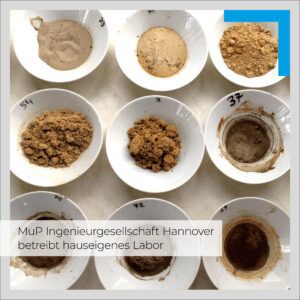

WHAT-WE-DO: Mull & Partner Ingenieurgesellschaft Hannover operates its own soil mechanics laboratory for the investigation of soil material in connection with subsoil investigations. The laboratory tests are used to evaluate and assess soil properties and to answer construction-related questions in the field of geotechnics and water management. They form the basis for earth static calculations for construction planning and modelling for water retention.
The in-house laboratory allows for particularly time- and cost-optimised project handling, as the soil samples taken in the field usually arrive at the laboratory on the same day and can be processed. In addition, reserve samples are stored for at least 6 months in order to be able to answer questions flexibly as they arise.
The following tests are carried out by M&P:
- Determination of the particle size distribution according to DIN 18123 by sieve analyses as well as combined sieve/slurry analyses
Depending on the particle size, sieve (d ≥ 63 µm), slurry (d < 63 µm) or combined analyses are carried out to determine the particle size distribution.
In sieve analysis, the sample, dried at 105 °C, is placed in a sieve tower with mesh sizes decreasing from top to bottom. After separation into individual fractions using a shaker, the residue on the individual sieves is weighed to determine the particle size distribution.
In the slurry analysis, the soil sample is stirred in a cylinder with water to form a suspension. A dispersing agent is added to prevent coagulation. Subsequently, a hydrometer is immersed in free-floating water. A reading on the hydrometer is taken after 30 seconds, then after 1, 2, 5, 15 and 45 minutes and after 2, 6 and 24 hours. The temperature is measured at the same time. An evaluation takes place with the help of the nomogram of Stokes' law according to Casagrande.
For a combined sieve/slurry analysis, the entire soil sample is first separated into fine and coarse fractions by wet sieving. Then a separate sieve or slurry analysis is carried out as described.
- Determination of the water content according to DIN 18121
The water content is calculated from the ratio of the mass of water present in the soil mw to the mass of the dry sample md determined. w = mw / md [-] The soil sample is weighed both before and after drying in the oven at 105 °C, the difference gives the water present in the soil mw.
- Determination of the consistency limits according to Atterberg or DIN 18122
The state form (consistency) of cohesive soils depends on the water content w of the soil. With decreasing water content, a cohesive soil passes from the liquid to the plastic, then to the semi-solid and finally to the solid state. These transitions were defined by Atterberg and are called: yield point wL, roll-out limit wP and shrinkage limit wS. For the respective experiments, the Casagrande yield point device with furrow opener is used, among other things.
#EngineeringForABetterTomorrow #mullundpartner #whatwedo #laboratory #building ground #geotechnics #grain sizes#analysis

